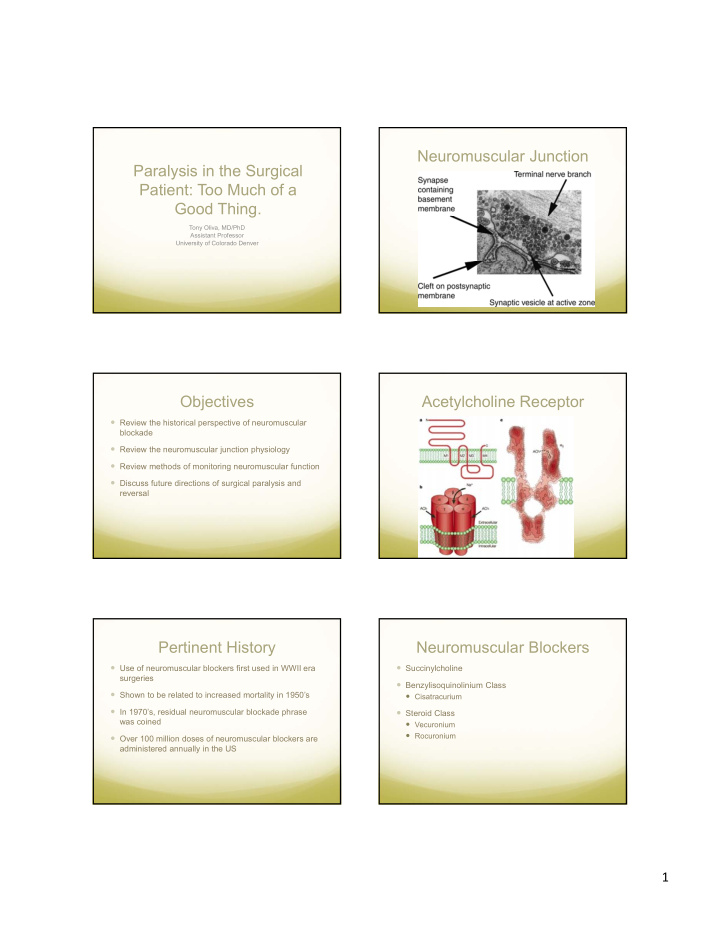



Neuromuscular Junction Paralysis in the Surgical Patient: Too Much of a Good Thing. Tony Oliva, MD/PhD Assistant Professor University of Colorado Denver Objectives Acetylcholine Receptor Review the historical perspective of neuromuscular blockade Review the neuromuscular junction physiology Review methods of monitoring neuromuscular function Discuss future directions of surgical paralysis and reversal Pertinent History Neuromuscular Blockers Use of neuromuscular blockers first used in WWII era Succinylcholine surgeries Benzylisoquinolinium Class Shown to be related to increased mortality in 1950’s Cisatracurium In 1970’s, residual neuromuscular blockade phrase Steroid Class was coined Vecuronium Rocuronium Over 100 million doses of neuromuscular blockers are administered annually in the US 1
Residual Neuromuscular Blockade (RNMB) Quantitative Monitors Is it a problem? Despite being gold standard, it is not often available or used Yes Optimal use requires calibration and normalization How do you define the problem? Limitations: Train of four (TOF) ratio <0.9 Requires a freely moving thumb How big of a problem is it? Is not fail-safe in residual weakness prevention Upward of 40% of patients in PACU are affected Increased risk of airway obstruction, aspiration, hypoxemia, reintubation. RNMB continued Qualitative Monitor Modes Why is it a problem? TOF Surgeon request for deeper blockade Most common mode used Interpret number of twitches (0-4) and presence of fade No reversal dose given Inappropriate reversal dose given DBS No use of muscle twitch device Occasionally used Incomplete understanding of how to use and interpret Interpret number of twitches (0-2) and presence of fade twitch devices Tetanus Reliance on clinical signs for adequate strength Commonly used What are solutions to the problem? Interpret presence of fade either at 50 or 100 Hz for 5 seconds Appropriate neuromuscular function monitoring PTC Appropriate dose of reversal agents Rarely used Interpret number of twitches after 5 second tetanus Neuromuscular Function Monitoring Monitoring Site Quantitative nerve monitor Site matters Gold standard Ulnar nerve is most studied site Provides a measured TOF ratio Quantitative monitors use this site Monitors the ulnar nerve and adductor pollicis brevis Level of blockade correlates to oropharyngeal blockade Qualitative nerve monitor Facial nerve is most convenient site Various modes: TOF, double burst stimulation (DBS), Level of blockade correlates to diaphragm blockade tetanus, post-tetanic count (PTC) Most commonly used monitor Posterior tibial nerve is an occasional site Monitors the ulnar nerve, facial nerve, and posterior tibial Does not correlate well to ulnar nerve nerve 2
Neostigmine Reversal Sugammadex Dosing Mainstay of neuromuscular blockade reversal for Shallow to moderate blockade decades by inhibiting acetylcholinesterase 2 mg/kg Highly variable time to completely reverse Profound blockade neuromuscular blockade 4 mg/kg Associated with numerous muscarinic side effects: Immediate reversal following RSI dose bradycardia, hypotension, bronchoconstriction, and 16 mg/kg excessive secretions. These are usually treated by concurrent administration of glycopyrrolate. Sugammadex Reversal Moderate Blockade FDA approved in December 2015 Currently used in ~70 countries with ~12 million patients receiving drug by mid 2015 Poised to become the predominant reversal agent Studies for sugammadex have provided excellent data for neostigmine as well Sugammadex Pharmacology Profound Blockade Molecule is a cyclodextrin with a center cavity containing anionic character to bind and encapsulate steroid NMBs that have cationic character via their quaternary amine group 1:1 binding Not metabolized Renal excretion Elimination half life is ~2 hours 3
Immediate Reversal Sugammadex Adverse Events Hypersensitivity ~0.25% Cutaneous manifestations Sneezing Rhinorrhea Nausea/Vomiting Anaphylaxis <0.1% 4
Recommend
More recommend